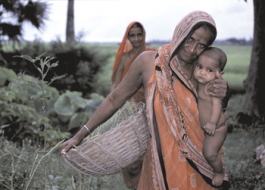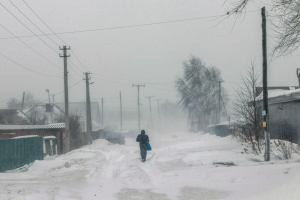Feeling helpless about starving children in Asia or even next door? If you're looking for ways to put food on your neighbor's tables, these five practical suggestions are a …
Facts are facts: There is enough food in the world to feed the world. So why do 1 billion still go hungry? Why do 30,000 die every day of starvation? And why does the number of hungry people rise at a rate of 5 million per year?
Catholic Relief Services' food aid expert William Lynch says it is quite simply a lack of desire. "Of course there is enough food to give to those who need it," he says. "But is there the will? Absolutely not."
Most agree the eradication of hunger and poverty depends on a combination of person-to-person compassion in the form of organized aid as well as an overhaul of societal and civic structures that prevent equitable access to food. The task seems Herculean, and the average Joe is easily discouraged.
Still, one would be hard-pressed to find a person of faith who doesn't see feeding the hungry as part of a Christian's duty. "The theme of meals and eating permeates the gospels," says Mark Brinkmoeller, director of church relations for Bread for the World, an anti-hunger organization. "In the Gospel of Matthew, Jesus says, ‘Whom have you fed?' And we will be judged on this. This is intrinsic to our faith."
Sen. George McGovern, former ambassador to the United Nations' food agency and coauthor of Ending Hunger Now (Augsburg Fortress), puts it in blunt terms: "If we fail to do this, we will stand condemned before the bar of history. In that case, shame on you, and shame on me."
The biggest problem facing the hungry is the poverty trap: the cyclical combination of no money, no food, and no health care. Malnutrition leads to illness; illness drains financial resources; drained finances lead to malnutrition. Factor in a lack of access to education, financial services, or credit-all of which prevent upward economic mobility-and you've got a person who is-in a word-trapped.
On the international scene, we see photographs of emaciated victims of famine caused by drought, civil war, or natural disaster. We see children with distended bellies and vacant eyes, collarbones and shoulder blades protruding. These are the extreme, but all too frequent, cases. About 8 percent of child deaths from starvation are a result of emergency food shortage.
In our own country we may not see hunger the way we can in the midst of international crises, but it's there: in students who can't concentrate because their stomachs are empty, in elderly people who skip meals, and in parents who forego their own needs so that their kids can eat. America's Second Harvest served 25.3 million Americans with emergency food aid last year, including almost 9 million children.
Meanwhile thousands of people look for ways to fill all these empty bellies, and among them a thousand different approaches can be found. Here are five of those ways and what you can do to join the effort.
1. Give a man a fish
The most obvious way to help hungry people is, of course, to give them food. Countless groups here and abroad raise money for direct food aid, distributing meals to people in crisis.
When the tsunami hit Asia at 9:26 a.m. on Dec. 26, 2004, Catholic Relief Services and its partners were serving emergency meals by lunchtime. For months they continued to provide food and shelter for the displaced victims until they could get back on their feet.
Direct food aid serves an immediate need-an emergency situation. CRS, and many others like it, also seeks to establish programs that will serve the long-term needs of the community: sufficient nutrition, healthcare, education, and employment.
The secret to Heifer International's success is that animals reproduce, says Ray White, one of Heifer's directors, of the worldwide organization that provides domestic animals to needy families in the United States and abroad. "If you put two tractors together, you don't get a third tractor," he says.
From water buffalo, cows, and sheep to rabbits, chickens, and honey- bees, Heifer provides animals that will be a source of income, food, or both, and gives people the tools they will need to succeed, like training in animal care, agricultural techniques, finances, marketing, reading, and writing. Recipients promise to pass on the gift by donating at least one of their animal's offspring to a neighbor in need.
"It's amazing how one small animal can completely change the life of a family," White says.
White recently returned from a Heifer project in Nepal, where a women's cooperative received a small herd of goats several years ago. The co-op now has more than $10,000 in a bank savings account and was able to pass on 56 goats-more than they started with-to another women's co-op.
2. This time it's political
CRS' Lynch recently returned from Haiti, where the average person is experiencing a 460-calorie food deficit per day. "That's lunch. Everybody there is missing a meal every single day."
Lynch points to a change in government policies to gain ground in the battle against hunger. "Ending hunger is possible," he says, "but we have to overcome something in our nature. As Catholics, we don't demand of our Catholic legislators that they support a preferential option for poor, but we do judge them on certain other policy points."
With the 2008 presidential campaign already underway, it will be up to concerned Americans to make sure poverty relief has a place on each candidate's agenda. Lynch sizes up the problem: "There's no constituency for the poor. Their vote is not a significant voice." So who will speak for them?
Bread for the World (BFW) believes that hunger is indeed a political problem, so it lobbies the U.S. government to adopt or strengthen legislation that will get food to those who need it. BFW looks both at domestic hunger-including dispelling the myth that there is no domestic hunger with facts such as "14 million children live in households where people have to skip meals or eat less to make ends meet"-and channeling U.S. funds to international food aid.
"The difficulty we face, though, is that there is so little faith in government and its ability to solve problems. When you serve at a food pantry, you see the person actually receive the can of food you give; it's tangible. But through government there is a disconnect."
BFW provides background on legislation, then asks people to write letters to their congressional representatives or the president. They also encourage phone calls and visits to representatives.
BFW's efforts, along with its lobbying partners on Capitol Hill, including Catholic Charities USA and the United States Conference of Catholic Bishops, secured a $1.4 billion increase in foreign aid earmarked for poverty relief in the 2007 budget. They also helped to avoid major cuts proposed to food stamps and other hunger-relief programs.
In 2007 BFW is focusing on the Seeds of Change campaign, addressing broad reforms proposed to the Farm Bill, which comes up in Congress every five years for reapproval. Lynch offers a suggested revision to the Farm Bill: "An excess of $3 billion to $5 billion is spent each year to keep farmland from being farmed. We could use that money to buy food to feed the poor. These farmers could grow food specifically for the poor, and the U.S. could buy it and distribute it."
Also on the agenda is passing the Hunger-Free Communities Act, a bipartisan bill that encourages local groups to create a social safety net in their own communities.
Ending world hunger will take the political will of the world as well as the United States. According to Jeffrey Sachs, economist and founder of Millennium Promise, the question is not "Can rich countries afford to help the poor ones?" but "Can the rich afford not to?" His answer, of course, is no. And while Sachs believes in the fundamental moral obligation to alleviate poverty and hunger around the world, his book The End of Poverty (Penguin) appeals even more to the purely economic rationale.
Sachs suggests a five-fold approach for international investment. All five elements must be implemented simultaneously to make improvements that last: agriculture, healthcare, education, infrastructure, and safe drinking water and sanitation.
Under the United Nations Millennium Development Goals, the 22 richest countries in the world pledged to give 0.7 percent of their GNP to official development assistance. Similar pledges have been made to the United Nations since 1970. Yet few of these industrialized countries are making good on their promises. In 2005 only five countries met or exceeded a 0.7 percent contribution. The United States gave only 0.22 percent, accounting for almost half of the total assistance shortfall.
Sachs insists that international funds at even 0.5 percent of rich-world GDP would be enough to end extreme poverty in the world. He cites the example of Ghana, which developed a poverty reduction strategy in 2002 that called for $8 billion in foreign aid over five years. Sachs calls the strategy "exceptionally well-designed" with high potential for success. But donors would only come up with $2 billion, and Ghana's attempt at attacking poverty came up woefully short.
Sachs may succeed where others have failed with his ability to popularize the economics of poverty eradication. He's toured Africa on highly publicized trips with superstars Bono and Angelina Jolie, who are happy to lend their names and money to the effort. Students at Columbia University were even selling T-shirts that read "Jeff Sachs is my homeboy."
3. Bank it
A major problem for most poor people is that they do not have access to financial services such as lines of credit, savings accounts, or any kind of financial advice or planning. In most of the developing world, bank fees for a simple account are out of reach. As such, cash hidden under a mattress or in a jar is about the only choice.
Often it would take only a very little bit of money (by U.S. standards) to allow poor people to get a leg up on their financial difficulties. A $50 loan could be enough capital to start a fruit stand or a sewing shop. In theory, a person would then be able to support herself sufficiently, as well as pay back the loan over time.
Susy Cheston is senior vice president of Opportunity International, a Christian microfinance organization that serves nearly 1 million clients with small loans. Cheston tells the story of Ana Martinez, a mother of five children in El Salvador. Her family lost everything they had in an earthquake, and Martinez's husband could not find work. They lived in a shantytown in a one-room, corrugated metal house with no plumbing or electricity. But Ana could make beautiful piñatas. She told Cheston, "If I had some paper and materials, I could sell so many of these."
So Cheston arranged for a $100 loan, which Martinez used to buy paper, glue, and chicken wire. She quickly increased her business to take in $4 per day, then $6 a day. The first things she did were to enroll her children in school and buy them shoes. A few years later they moved into a three-room concrete home with a roof, electricity, and plumbing.
Well-meaning people often ask Cheston how they can send shoes to the children in El Salvador. "I say to them, ‘We certainly could have bought shoes and sent them to Ana, but instead we invested $100 so she was able to buy them herself.' Most importantly she has the pride, dignity, and joy of being able to care for her own children."
When Muhammad Yunus started lending money to poor people, critics said he would never see it repaid. But in fact Yunus found the opposite to be true. From cash loans out of his own pocket, he built the Grameen Bank in Bangladesh, which boasts a 99 percent repayment rate, much higher than that of commercial lenders or credit cards. The recipient of the 2006 Nobel Peace Prize, Grameen Bank now has 6.39 million borrowers, 96 percent of whom are women, and provides services in 69,140 villages.
According to Cheston, only 5 to 10 percent of demand for credit in poor communities is met, and savings and insurance are also needed. Out of the 3 billion poorest people in the world, only 10 million have insurance, and a poor person has the highest chance of being a victim to natural disaster, a health problem, or theft. "It's like Chutes and Ladders for them," says Cheston. "Every time they can get a leg up on their finances, they hit one of the chutes of a medical emergency or a robbery. It's a huge setback."
4. Sow the seeds of love
Another approach to filling empty bellies is to improve yields of local crops, particularly on family farms. Some argue whether large-scale agro-tech programs, such as the famous post-World War II Green Revolution, are successful against hunger, since increased production of food does not necessarily mean that that food is reaching the mouths of the hungry, or even being sold for a profit that benefits the hungry. Furthermore, a heated debate goes on over genetically modified seed varieties.
But most can agree that-especially in areas that have had unsuccessful harvests due to drought, disease, insects, or other pests-heartier seeds, improved fertilization methods, and irrigation can increase food production and help to feed the population.
One success story is the introduction of nitrogen-fixing trees in Sauri, Kenya, a Millennium Promise project. The International Center for Research in Agroforestry introduced a method of planting trees that are able to convert atmospheric nitrogen into a compound that is nutritious to food crops, and is thus a natural substitute for chemical nitrogen fertilizer. As an added benefit, the trees also provide wood for cooking fires.
An Australian institute has developed another way to spread improved agricultural techniques and technology to the developing world using the Internet. Cambia promotes "open source" technology for agriculture, in the same way that software developers share ideas. Much of today's agricultural advancement has been protected by patents that make it expensive or impossible for farmers in the developing world to access it.
Cambia's founder is Richard Johnson, a biotech scientist responsible for developing the primary building block to plant DNA recombination.
"If we're really interested in ending world hunger we have to be focused on what resources are available," says Johnson. "The most important resource is human creativity and commitment to innovate. We are working toward changing options-structurally-in this area."
5. You are what you eat
In contrast, Diet for a Small Planet (Ballantine) author Francis Moore Lappé, who credits Catholic social teaching as one of her influences, says that higher agricultural yields are simply not the answer, since there is already enough food to feed the whole planet yet the food is not distributed equally.
The root of the trouble is the centralization of economic power: Those who have power dictate what foods are produced and how they are made available. Those who don't have power are at the mercy of the system. "I came to see how our production system treats even an essential ingredient of life itself-food-as just another commodity, totally divorcing itself from human need," Lappé says.
A prime symptom of this problem, says Lappé, is that nearly half of all grain worldwide is fed to livestock. In the United States it takes an average of 16 pounds of grain fed to cows to produce one pound of beef. Lappé says a meat-centered diet is inherently wasteful, because humans can get protein from plant sources, and Americans already eat twice the amount of protein their bodies can use. In short, wealthier nations create a market demand for meat, so grain gets fed to livestock, and those who cannot afford meat are left without.
Interestingly Lappé is not a vegetarian. "What I advocate is the return to the traditional diet on which our bodies evolved. Traditionally the human diet has centered on plant foods with animal foods playing a supplementary role," she says.
Lappé's daughter, Anna Lappé, has joined the fight for food equality and together they founded the Small Planet Institute. "We know we have persistent hunger because of lack of democracy, not lack of food," says Anna. "People who go hungry have a lack of power over their own food choices. We can shift food democracy by using our own power to choose food from local sources."
For those who find choosing locally produced food inconvenient and time-consuming, Anna came out with a cookbook called GRUB: Ideas for an Urban Organic Kitchen (Penguin/Tarcher). Lappé partnered with award-winning chef Bryant Terry, who developed the recipes, from comfort-food macaroni and cheese to "Smoky South American Seitan Stew."
"Every time you spend money on food that has traveled more than 1,000 miles to get to you, you're paying for advertising and marketing of the products," Lappé says. "But when you buy from the farmer, your money goes directly to the farmer."
One way to buy direct from farmers is through community supported agriculture (CSA) cooperatives, in which consumers buy a share in a local farm, which then delivers a portion of its harvest to each shareholder over the growing season. To increase variety and share resources, many CSA groups include several different family farms. Generally the CSA has pick-up points in town centers for weekly or biweekly shipments. Some even offer right-to-your-door delivery.
Beyond a personal diet change, though, citizens must contribute to the redefinition of power structures, making steps toward a truer democracy, Frances Moore Lappé says. Development, too, must be redefined "not merely in terms of more production or consumption, but first and foremost in the changing relationships among people."












Add comment